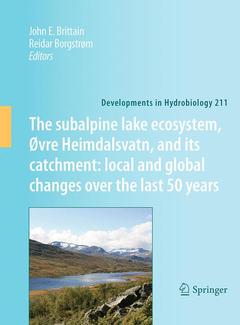Description
The subalpine lake ecosystem, Øvre Heimdalsvatn, and its catchment: local and global changes over the last 50 years, 2010
Developments in Hydrobiology Series, Vol. 211
Coordinators: Brittain John E., Borgstrøm Reidar
Language: English
Subjects for The subalpine lake ecosystem, Øvre Heimdalsvatn, and...:
The subalpine lake ecosystem, Øvre Heimdalsvatn, and its catchment: local and global changes over the last 50 years
Publication date: 10-2014
126 p. · 19.3x26 cm · Paperback
Publication date: 10-2014
126 p. · 19.3x26 cm · Paperback
The subalpine lake ecosystem Ovre Heimdalsvatn, and its catchment: local and global changes over the last 5
Publication date: 05-2010
126 p. · 19.3x26 cm · Hardback
Publication date: 05-2010
126 p. · 19.3x26 cm · Hardback
Description
/li>Contents
/li>Comment
/li>
environmental variables are estimated and then applied to fossil assemblages under the assumption Plant and animal remains are often found well that the biota is in equilibrium with concurring preserved and in large quantities as fossils in lake environmental conditions. We have used fossil pollen sedimentary deposits. The composition of the fossil assemblages to reconstruct changes in past mean July assemblages, the biological proxies, can be used to air temperatures and changes in mean annual prec- infer environmental conditions at the time of de- itation (Birks & Birks, 2003). Plant macrofossils were sition. This is based on the uniformitarian assumption used to con?rm and to give more robust interpre- that particular species assemblages of the past have tions about past vegetation and climate than the been shaped by speci?c sets of environmental pollen evidence alone (Birks & Birks, 2000) and has conditions, and that these conditions are re?ected been widely used to con?rm the local presence of tree by the same species assemblages today (Rymer, species in studies of past tree-lines (Barnekow, 2000; 1978; Birks & Birks, 1980). Different proxies used to Bjune, 2005; Eide et al. , 2006). Chironomids (n- reconstruct past environmental conditions have in- biting midges) were used to infer past mean July air vidual strengths and weaknesses.
Preface.- The Norwegian reference lake ecosystem, Øvre Heimdalsvatn.- Holocene climate and environmental history of Brurskardstjørni, a lake in the catchment of Øvre Heimdalsvatn, south-central Norway.- The development of new algorithms for remote sensing of snow conditions based on data from the catchment of Øvre Heimdalsvatn and the vicinity.- Long-term trends in water temperature and ice cover in the subalpine lake, Øvre Heimdalsvatn, and nearby lakes and rivers.- Between-year variations in the development of crustacean zooplankton in the Norwegian subalpine lake, Øvre Heimdalsvatn.- Long-term changes in the littoral benthos of a Norwegian subalpine lake following the introduction of the European minnow (Phoxinus phoxinus).- The brown trout (Salmo trutta) in the lake, Øvre Heimdalsvatn: long-term changes in population dynamics due to exploitation and the invasive species, European minnow (Phoxinus phoxinus).- Diet overlap between introduced European minnow (Phoxinus phoxinus) and young brown trout (Salmo trutta) in the lake, Øvre Heimdalsvatn: a result of abundant resources or forced niche overlap?.- A long-term study of catchment inputs of 137Cs to a subalpine lake in the form of allochthonous terrestrial plant material.- Long-term trends and variation in 137Cs activity concentrations in brown trout (Salmo trutta) from Øvre Heimdalsvatn, a Norwegian subalpine lake.- The importance of size and growth rate in determining mercury concentrations in European minnow (Phoxinus phoxinus) and brown trout (Salmo trutta) in the subalpine lake, Øvre Heimdalsvatn.
In-depth ecological study of a lake and its catchment Impacts of climate change, long-range pollutants and invasive species on lakes Basis for developing management and monitoring strategies
© 2024 LAVOISIER S.A.S.




